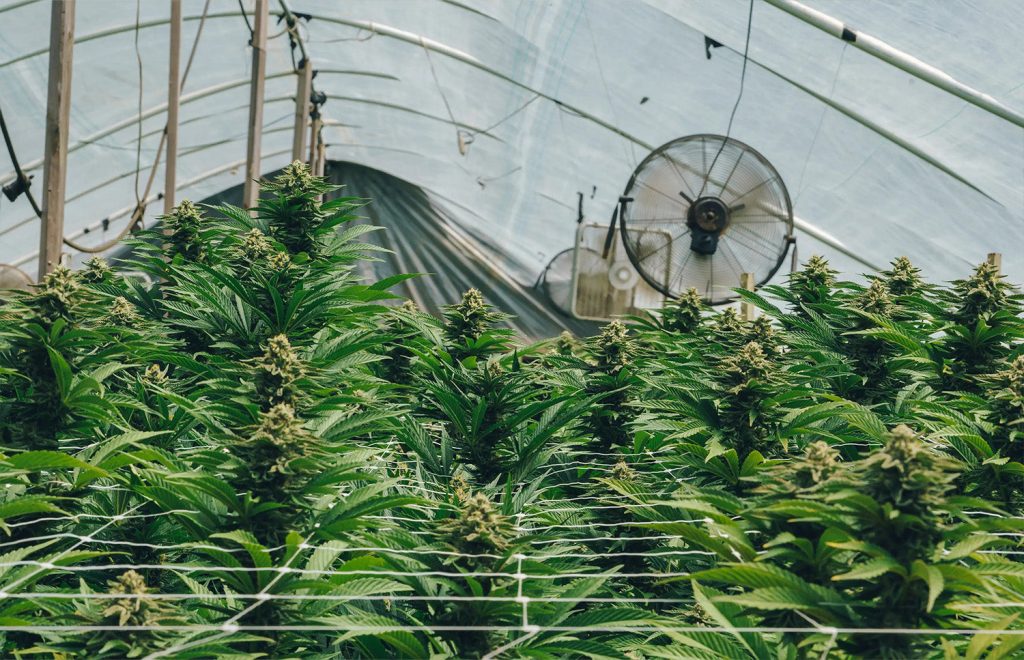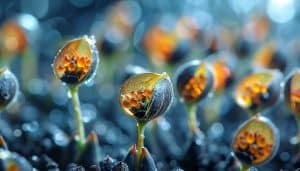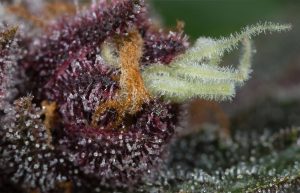- Viruses are a phenomenon that dominates more news than ever, certainly because the coronavirus has changed society as many human lives over the past 2 years.
- They are increasingly present in our environment, they affect more and more living beings around the world in a lasting way. Plants in general, as cannabis are also affected by various and varied phytoviruses.
- During this article, we explain the latest discoveries concerning these phytovirus, even if many mysteries still surround these strange plagues and modern -day pests.
- Viruses and cannabis plants
- Vectors that promote the spread of phytovirus
- The tobacco mosaic virus in cannabis cultivation
- The different viruses that harm the cannabis plant
- Cannabis prevention and treatment measures
VIRUSES AND CANNABIS PLANTS
Generally, Lphytovirus Viruses affect plant organisms by definition. More concretely, these are intracellular parasites which require the support of a host organism to ensure their own reproduction. It is good to know that the level of global scientific knowledge concerning phytovirus, is far less extensive than that of the animal world still today.
Which is ultimately quite logical, because it is certainly more revealing of the symptoms that could occur in humans. However, nowadays different viruses are now clearly identified as harmful to cannabis plants with high content in THC or CBD from “seeds” because they have the capacity to cause serious problems, making the harvest uncertain.
Even if the origin of these viruses is still unexplained for the time being, the scientific community has highlighted three theoretical hypotheses explaining their origins. The first constitutes a hypothesis regressive, which clearly means that these viruses come from microscopic cells which infected cells of a larger size, and which lost part of their genetic composition during their evolution.
The second can be explained by an original hypothesis cellular, which means that the viruses would have been formed from different parts of DNA and the RNA of organisms whose volume is greater. The last and third hypothesis is that of coevolution, which explains that they were made up of protein molecules and nucleic acids.
THE Tobacco mosaic virus (VMT) or TMV in English (Tobacco Mosaic Virus), is the first of its kind to have been discovered by Adolf Mayer in 1886. It was from 1898 that Martinus Beijerinck was able to reproduce the experiences that had been carried out before by Dimitri Ivanovsky in 1892.
The latter used “virus” terminology for the first time at that time, to characterize the symptoms of the tobacco mosaic virus. For the latter, it was therefore obvious that the origin of this disease came from the presence of mold, or that of a bacteria.
The majority of identified phytovirus, affect certain species of plants precisely, which clearly reveals to us that they require at least one type of concrete host cells in order to be able to ensure their reproduction, which limits their potential infections to a number of limited species.
In any case, we are witnessing in the natural environment, with the development of a multitude of viruses which are capable of causing serious problems on a wide set of agricultural species, which gives sacred cold sweats to cultivators around the world.
VECTORS THAT PROMOTE THE SPREAD OF PHYTOVIRUS
According to certain scientific observations, it seems that phytovirus are basically protein capsules containing a part of genetic sequence, the missing part prevents their mobility from one plant to another. Then naturally comes a question, how are they therefore capable of ravaging so much at the heart of a culture?
In fact, their spread is favored by the presence of different Viral vectors, in more detail, these are living organisms which convey these viral charges of a plant infected with the disease, towards another healthy plant to finally facilitate the obtaining of new host cells.
Most of the time, these are the insects or harmful cannabis such as aphids, cochets, nematodes, red spiders, thrips or white flies, which play the role of direct viral vectors. Without knowing it, they are even the cultivators Who assure this role of transmission, by treating and taking care of cannabis plants from “seeds” with high THC or CBD, with close proximity.
THE TOBACCO MOSAIC VIRUS IN CANNABIS CULTIVATION
The tobacco mosaic virus is as its name suggests, a harmful viral phenomenon especially for the tobacco plant, although it tolerates more 125 species of 9 families of plants Different as host. However, many cultivators still doubt and seek to check with certainty, how the tobacco mosaic virus precisely attacks cannabis.
It is still good to keep in mind that a virus can sometimes be identified by a specific acronym, although in fact it is a different strain corresponding to another viral phenomenon (Like the hemp mosaic virus (MHV), which is actually the strain cowpea tobacco mosaic virus.
The VMT capsule is made up of at least 2000 Protein molecules Covering and a RNA molecule in a single part. Unlike many other viral phenomena, once it enters the host cell, its protein capsule is dissociated from the whole, releases viral RNA and begins to reproduce its own genome.
The disease causes different symptoms on plants within culture, because we can observe significant discolorations between the veins of the leaves the youngest, which should not be confused with the Nutrient deficiency symptoms. These color changes are accompanied by the development of spots with the appearance of a mosaic with clear and obscure variable forms. It is also possible to see the leaves withered, until finally take on a rough appearance in terms of touch.
The lower parts of the marijuana plant are also affected, especially if the climatic vagaries are not on our side, this means more concretely, if we have hot temperatures and dry conditions. You will also be able to observe a necrotic action in the leaves, and you will then witness a generalized slowdown in growth or from the flowering of plants from “seeds” with high THC or CBD.
The VMT or TMV in English (Tobacco Mosaic Virus), is certainly one of the most stable phytovirus as it is. In the event that the room temperature does not drop below 4 ° C, the latter retains perfect stability. A culture made in greenhouses or located in a botanical garden, constitutes ideal breeding conditions thanks to their high and stable temperature, but also thanks to the very wide assortment of the different plants which are stored at this place .
THE DIFFERENT VIRUSES THAT HARM THE CANNABIS PLANT
High -content cannabis plants can potentially be affected by the VMT, but also by many other phytovirus, some of which are not yet clearly listed. Fortunately, the majority of these phytovirus do not affect cannabis because they ravage other families or species as well.
We can add that plants can be infected with several viruses at the same time, which makes the distinction of these different viral phenomena very difficult for cultivators. The latter must adapt to the specificities of each viral phenomenon, such as a disease, to which it must apply the best corresponding treatment.
It would seem that nearly 900 phytovirus are now identified, but the road is still long in terms of scientific studies, because a small amount of them have made the fruit of sufficiently deep and documented investigations. Nowadays, only two viruses are clearly listed as particularly harmful to cannabis.
It’s about Hemp mosaic virus (HMV, HEMP Mosaic Virus), and the hemp streak virus (HSV, Hemp Streak Virus). These two viral phenomena concretely affect cannabis plants, thanks to the action of viral vectors such as aphids, caterpillars, thrips and red spiders.
Some scientific community studies have also shown that the Tobacco rings stains virus (TRSV, Tabacco Ringspot Virus) and the Tobacco Straw Virus (TSV, Tobacco Streak Virus), also have the capacity to create such infection by causing symptoms similar to those caused by VMT.
It’s exactly the same for the Luzerne mosaic virus. Quite strangely, they all use seeds and aphids as vectors of these parasitic diseases. THE Arabic mosaic virus (ARMV) also seems to be able to wreak havoc on cannabis plants through nematodes and seeds, but asymptomatic.
THE Cucumber mosaic virus (CMV), affects the cucumber plants like those of Marijuana, again, thanks to the active participation of aphids or seeds as viral vectors. In conclusion of this part, it would seem that the tomato rings stains virus (Tomrsv), also uses cannabis as a host plant.
There is also a viroid that comes from the hop, which is quite virulent and which deeply affects cannabis plants. THE Latent viroid hop (HPLVD or Latent viroid hops in English) which has appeared in the United States for a few years now, has become a serious problem for many professional cultivators in the country of Uncle Sam in recent years.
A prestigious Californian “Nursery” has sold many infected clones to many companies in the sector there, and a large majority of cultivators have taken time to understand what was going on in the heart of their culture. This viroid has fairly misleading symptoms in fact, because the foliage demonstrates as nutrient deficiencies, the growth or flowering of plants slowly slow down, the cultivators are misled, however the disease settles in permanently.
This viral phenomenon can be asymptomatic for a certain period, then the symptoms can suddenly be declared. This can cause the net loss of certain genetics, we are witnessing a significant drop in flower production and cannabinoids at the same time.
CANNABIS PREVENTION AND TREATMENT MEASURES
Unfortunately as for certain fungal diseases caused by certain parasitic fungi that affect plants, there is not yet suitable treatment, allowing to completely and quickly eliminate infection as the adverse effects of phytovirus affecting the culture of cannabis indoors and outdoors.
Like for Many diseases caused by parasitic fungi such as botrytis, mildew, powdery mildew, alternia, fusarium Or the septoria of the leaves, whose symptoms can be characterized by the appearance of rot, it is necessary to set up a series of prevention measures.
It is fundamental for the cultivators of exhaustively clean their cannabis cultivation space indoors, From floor to ceiling, picking up all leaves like all plant waste lying around. It is crucial to always try to Maintain a stable temperature When you want to grow indoors. Also try to get a good air renewal, like a homogeneous ventilation which will limit the appearance of vitiated air pockets, which are harmful. One capital aspect here is to maintain a stable humidity level, without excessive variations.
It should be kept in mind, that the leaves constitute an ideal habitat for the development of the characteristic rot of these parasitic fungi. Bad ambient climatic conditions, attract these fungal phenomena. Be sure to make fairly precise watering, with an amount of water and nutrients adapted to the period. Generally, cannabis plants need little water in the last 2 weeks of flowering. You have to be careful at this stage, because it is the ideal time to attend the appearance of a fungus like Botrytis.
You have to be vigilant in poor mastery of climatic parameters, as this can facilitate the arrival of cryptogamic diseases like Fusarium, which attacks the roots and which it is particularly difficult to get rid of. It seems logical, but we warn you that the consumption of cannabis flowers infected with fungi is dangerous for health. This can cause serious respiratory problems in humans, it is therefore better to abstain and avoid.
But not only, because cultivating under such conditions could also attract fairly easily The appearance of harmful insects, which could become a second associated problem, and thus compromise the chances of success of your harvest. A key aspect is above all in The choice of varieties of the best quality cannabis seeds you are going to buy.
It is very important to Select varieties that resist as much as possible to all of these harmful plagues, and whose characteristics must correspond to weather conditions of your geographic area. Indoor, climate management is of major importance, the treatment of air renewal and perfect humidity level management must be taken with the greatest consideration.
Make the application of a root stimulator once a week, as it will get vigorous and healthy roots, also with perfect absorption capacity. Root health is very important, as it directly contributes to Reinforcement of the immune system of your marijuana plants.
We can conclude that these viral phenomena are a modern evil of our time, surrounded by many mysteries, which we hope will be elucidated during the future years. This proves that chemicals do not seem to be as revolutionary as they seemed to be two decades ago. Nature will still give us many life lessons in the future.




